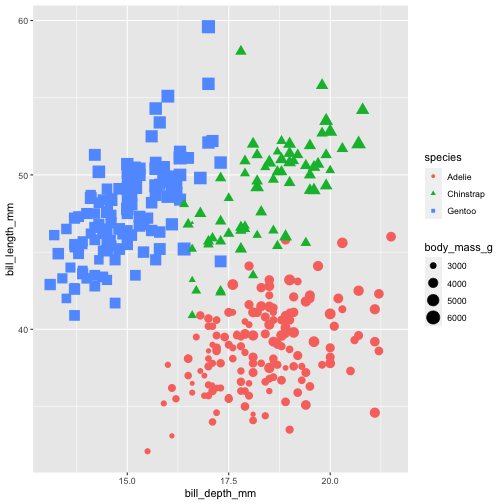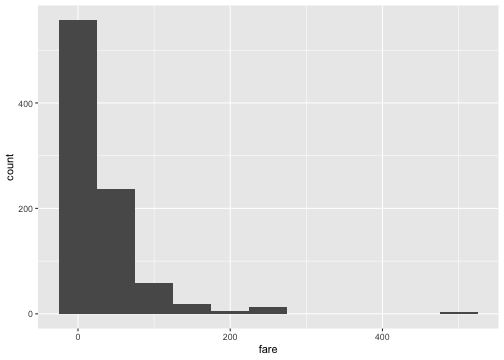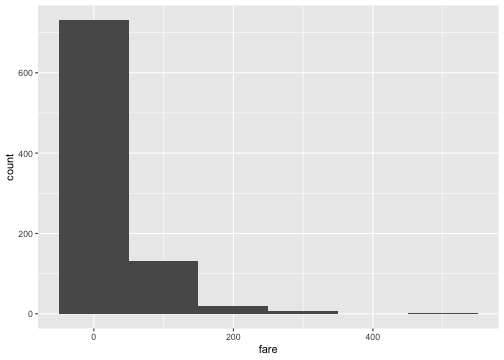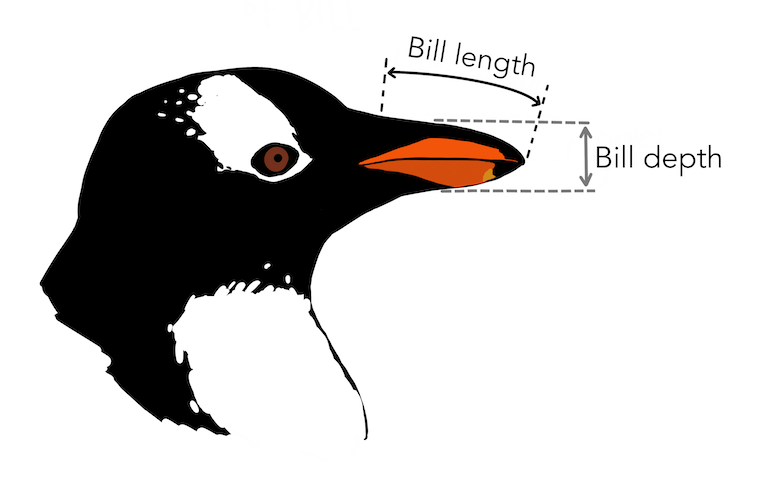Introduction to ggplot
Dr. Mine Dogucu
- This specific lecture will not necessarily show you beautiful plots.
This specific lecture will not necessarily show you beautiful plots.
In this lecture we will focus on how ggplot works.
This specific lecture will not necessarily show you beautiful plots.
In this lecture we will focus on how ggplot works.
In the next lecture we will improve the plots that we make.
ggplot is based on grammar of graphics.
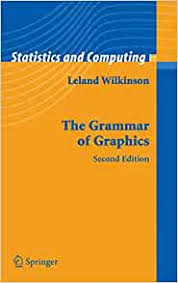
Data
glimpse(titanic)## Rows: 891## Columns: 6## $ survived <lgl> FALSE, TRUE, TRUE, TRUE, FALSE, FALSE, FALSE, FALSE, TRUE, TR…## $ pclass <chr> "Third", "First", "Third", "First", "Third", "Third", "First"…## $ sex <fct> sex, sex, sex, sex, sex, sex, sex, sex, sex, sex, sex, sex, s…## $ age <dbl> 22, 38, 26, 35, 35, NA, 54, 2, 27, 14, 4, 58, 20, 39, 14, 55,…## $ fare <dbl> 7.2500, 71.2833, 7.9250, 53.1000, 8.0500, 8.4583, 51.8625, 21…## $ embarked <fct> Southampton, Cherbourg, Southampton, Southampton, Southampton…The data frame has been cleaned for you.
Visualizing a Single Categorical Variable
If you could speak to R in English, how would you tell R to make this plot for you?
OR
If you had the data and had to draw this bar plot by hand, what would you do?

Possible ideas
- Consider the data frame
- Count number of passengers in each
pclass - Put
pclasson x-axis. - Put
counton y-axis. - Draw the bars.

These ideas are all correct but some are not necessary in R
- Consider the data frame
Count number of passengers in eachpclass- Put
pclasson x-axis. Put.counton y-axis- Draw the bars.
R will do some of these steps by default. Making a bar plot with another tool might look slightly different.

3 Steps of Making a Basic ggplot
1.Pick data
2.Map data onto aesthetics
3.Add the geometric layer
Step 1 - Pick Data
ggplot(data = titanic)
Step 2 - Map Data to Aesthetics
ggplot(data = titanic, aes(x = pclass))
Step 3 - Add the Geometric Layer
ggplot(data = titanic, aes(x = pclass)) + geom_bar()
Visualizing a Single Numeric Variable
Step 1 - Pick Data
ggplot(data = titanic)
Step 2 - Map Data to Aesthetics
ggplot(data = titanic, aes(x = fare))
Step 3 - Add the Geometric Layer
ggplot(data = titanic, aes(x = fare)) + geom_histogram()## `stat_bin()` using `bins = 30`. Pick better value with `binwidth`.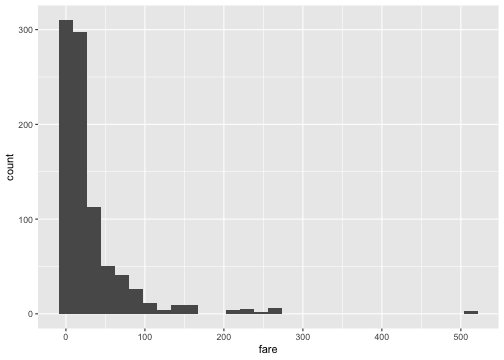
What is this warning?
## `stat_bin()` using `bins = 30`. Pick better value with `binwidth`.
ggplot(data = titanic, aes(x = fare)) + geom_histogram(binwidth = 15)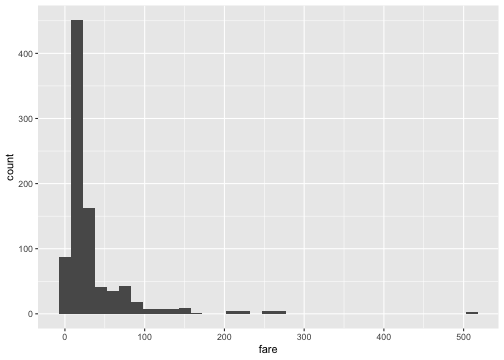
ggplot(data = titanic, aes(x = fare)) + geom_histogram(binwidth = 15, color = "white")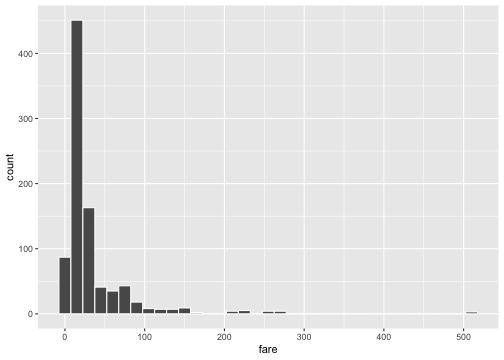
ggplot(data = titanic, aes(x = fare)) + geom_histogram(binwidth = 15, fill = "darkred")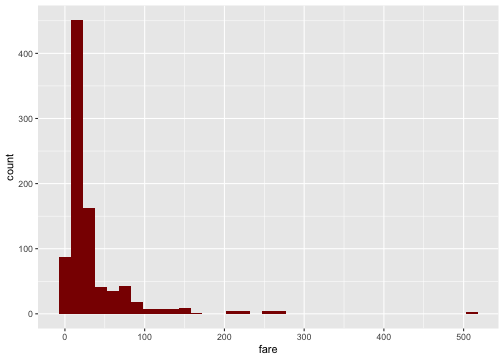
ggplot(data = titanic, aes(x = fare)) + geom_histogram(binwidth = 15, color = "white", fill = "darkred")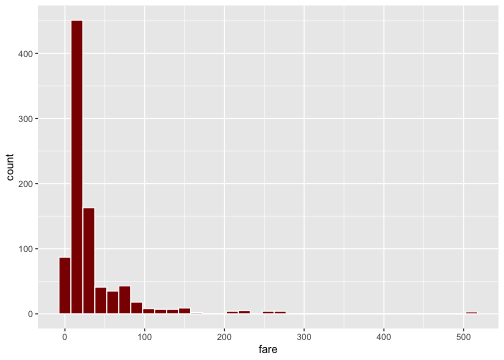
Visualizing Two Categorical Variables
Stacked Bar-Plot
ggplot(data = titanic, aes(x = pclass, fill = survived)) + geom_bar()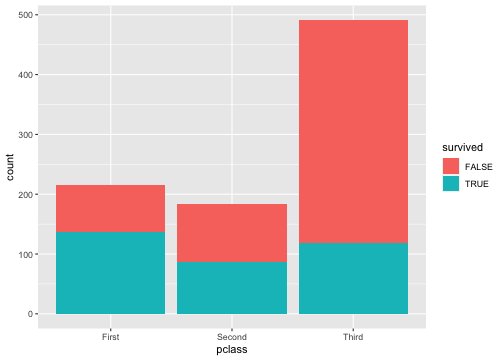
Standardized Bar Plot
ggplot(data = titanic, aes(x = pclass, fill = survived)) + geom_bar(position = "fill")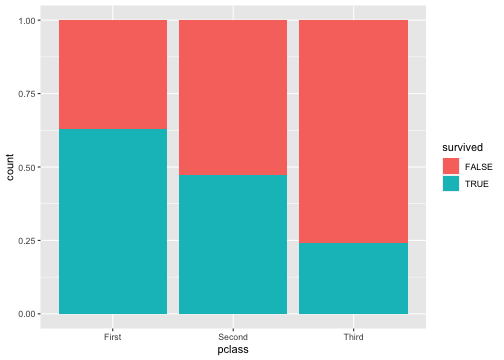
Note that y-axis is no longer count but we will learn how to change that later.
Dodged Bar Plot
ggplot(data = titanic, aes(x = pclass, fill = survived)) + geom_bar(position = "dodge")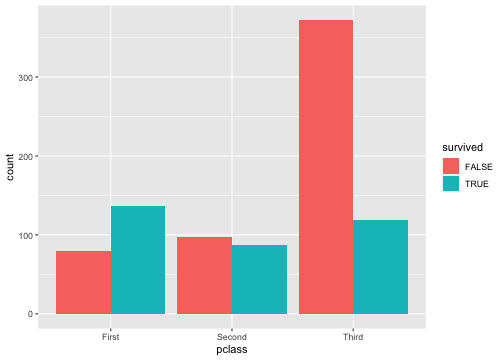
Note that y-axis is no longer count but we will change that later.
New Data
glimpse(penguins)## Rows: 344## Columns: 8## $ species <fct> Adelie, Adelie, Adelie, Adelie, Adelie, Adelie, Adel…## $ island <fct> Torgersen, Torgersen, Torgersen, Torgersen, Torgerse…## $ bill_length_mm <dbl> 39.1, 39.5, 40.3, NA, 36.7, 39.3, 38.9, 39.2, 34.1, …## $ bill_depth_mm <dbl> 18.7, 17.4, 18.0, NA, 19.3, 20.6, 17.8, 19.6, 18.1, …## $ flipper_length_mm <int> 181, 186, 195, NA, 193, 190, 181, 195, 193, 190, 186…## $ body_mass_g <int> 3750, 3800, 3250, NA, 3450, 3650, 3625, 4675, 3475, …## $ sex <fct> male, female, female, NA, female, male, female, male…## $ year <int> 2007, 2007, 2007, 2007, 2007, 2007, 2007, 2007, 2007…Visualizing a single numerical and single categorical variable.
## Warning: Removed 2 rows containing non-finite values (stat_ydensity).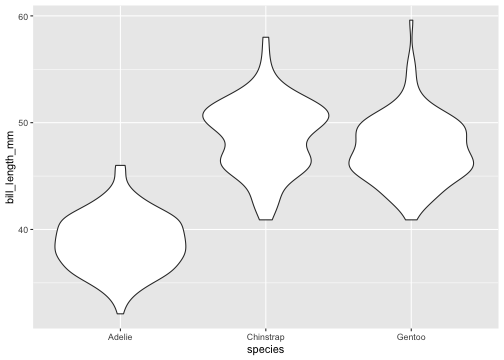
- Create a ggplot using the
penguinsdata frame. - Map the
speciesto the x-axis andbill_length_mmto the y-axis. - Add a layer of a violin plot.
ggplot(penguins, aes(x = species, y = bill_length_mm)) + geom_violin()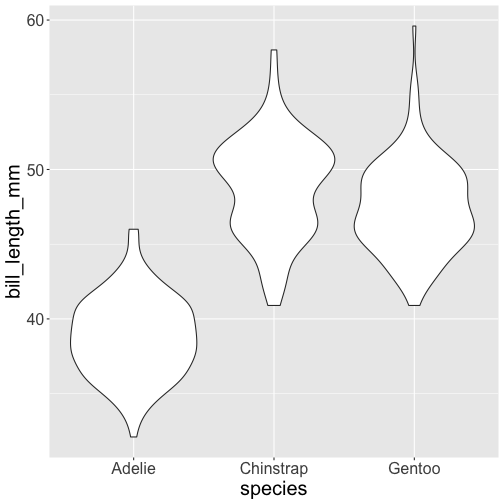
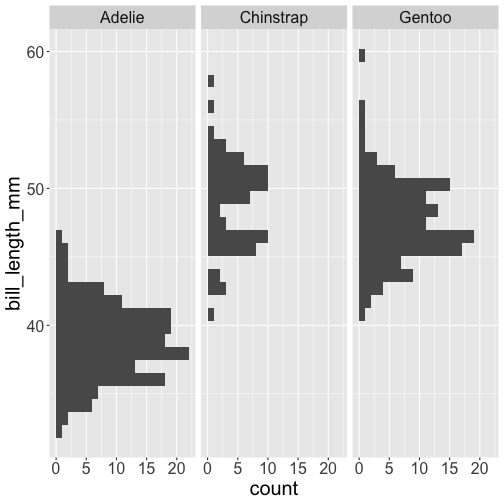
Visualizing Two Numerical Variables
ggplot(penguins, aes(x = bill_depth_mm, y = bill_length_mm)) + geom_point()## Warning: Removed 2 rows containing missing values (geom_point).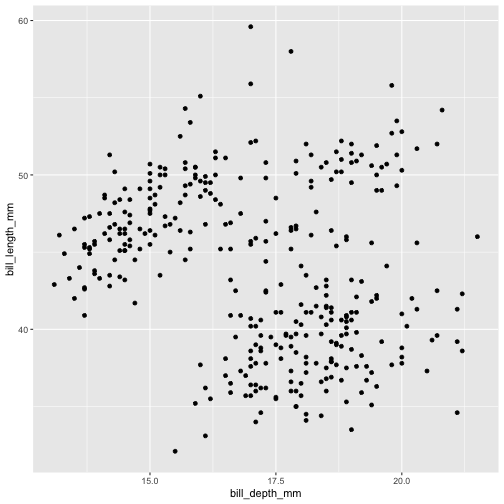
Considering More Than Two Variables
ggplot(penguins, aes(x = bill_depth_mm, y = bill_length_mm, color = species)) + geom_point()## Warning: Removed 2 rows containing missing values (geom_point).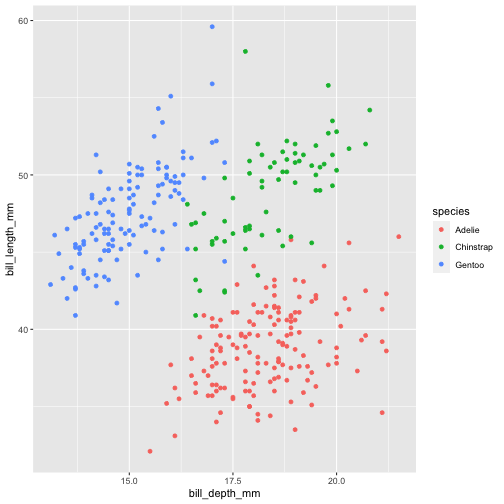
ggplot(penguins, aes(x = bill_depth_mm, y = bill_length_mm, shape = species)) + geom_point()## Warning: Removed 2 rows containing missing values (geom_point).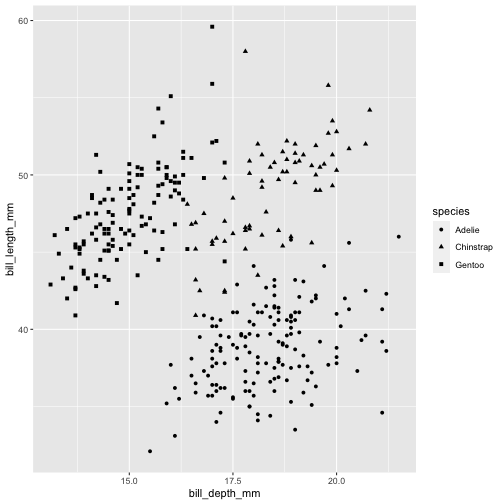
ggplot(penguins, aes(x = bill_depth_mm, y = bill_length_mm, shape = species)) + geom_point()## Warning: Removed 2 rows containing missing values (geom_point).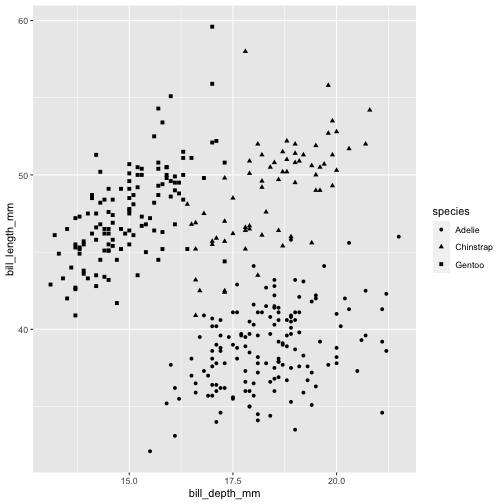
ggplot(penguins, aes(x = bill_depth_mm, y = bill_length_mm, shape = species, color = species)) + geom_point()## Warning: Removed 2 rows containing missing values (geom_point).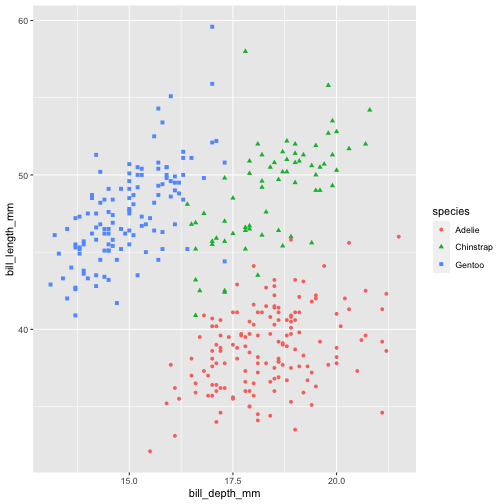
ggplot(penguins, aes(x = bill_depth_mm, y = bill_length_mm, shape = species, color = species, size = body_mass_g)) + geom_point()## Warning: Removed 2 rows containing missing values (geom_point).